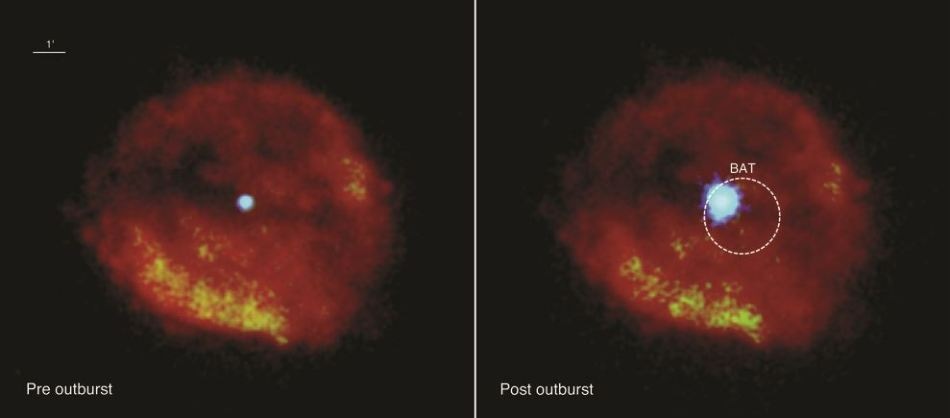Sep 15 2016
 Photos of the detection by the Burst Alert Telescope on board NASA's Swift space observatory of the slowest spinning neutron star discovered so far (9-2016), revealed in X-ray wavelengths by its outburst in the supernova remnant RCW 103.
Image: Penn State
Photos of the detection by the Burst Alert Telescope on board NASA's Swift space observatory of the slowest spinning neutron star discovered so far (9-2016), revealed in X-ray wavelengths by its outburst in the supernova remnant RCW 103.
Image: Penn State
Clues detected by NASA's Swift space observatory have led to the discovery of a new record-holder for the slowest spinning neutron star. The science and flight operations in the observatory are monitored by Penn State from the University Park campus.
Spinning neutron stars are a class of stars that comprise of extremely powerful magnetic fields in the universe. On June 22, 2016, a short burst of unusual X-rays were captured by Swift's X-Ray Telescope. These X-rays were generated from an object approximately 9,000 light-years from Earth.
The X-ray burst detected had extremely fast, intense fluctuations measured in milliseconds. This intriguing fingerprint rapidly triggered extra observations by teams of astronomers from all over the world who obtained observing time with other space observatories including NASA's Nuclear Spectroscopic Telescope Array (NuSTAR) and NASA’s Chandra X-ray Observatory.
A paper prepared by one team made up of astronomers at Penn State, NASA, Los Alamos National Laboratory, and universities in Italy, the United Kingdom, and Germany has been accepted for publication in the Monthly Notices of the Royal Astronomical Society.
Observations with multiple space telescopes have revealed that, while other neutron stars spin multiple times a minute, this object rotates only once about every 6.5 hours -- making it by far the slowest-spinning star in its class discovered to date. The data collected by Chandra show that this object has properties of a magnetar -- a type of neutron star with extremely powerful magnetic fields trillions of times as powerful as those of the Sun that can erupt with enormous bursts of energy.
David Burrows, Professor of Astronomy and Astrophysics, Penn State
The object is placed in the center of a colorful cloud of material that consists of the remnants of an ancient star that exploded as a huge supernova. RCW103, the name given to this supernova remnant, and the intriguing object located at its center, can be identified with an X-ray telescope similar to the one on Swift but is completely invisible at wavelengths that human eyes can spot.
This object has been of interest to Penn State astronomers for a long time. Gordon Garmire, now a Penn State Evan Pugh Professor Emeritus of Astronomy and Astrophysics, discovered in 1979 that the supernova surrounding this object was producing X-rays. He also discovered a huge X-ray flare shooting out into space from this object.
David Burrows, Professor of Astronomy and Astrophysics, Penn State
The Swift observatory, which has been responsible for detecting the extremely unusual and short X-ray spike developed by this object, has recently helped to reveal an object called an extreme magnetar at the heart of this supernova remnant. The data based on this object further suggests that it can become one of the extreme rotating magnetized neutron stars ever identified.
It has been confirmed by NASA that the data obtained from this trio of high-energy telescopes, and archival data from Chandra, Swift and the European Space Agency's XMM-Newton observatory, explains that the object possesses features of a magnetar, making it only the 30th known.